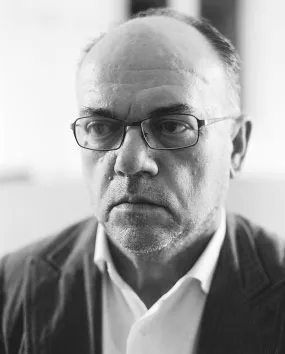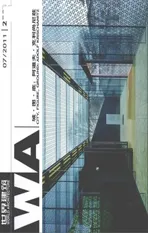建筑是建筑之间的差异性
2011-07-30阿道夫克利尚尼兹徐知兰
阿道夫·克利尚尼兹 徐知兰

1 阿道夫·克利尚尼兹/Adolf Krischanitz(摄影/Photo: Elfie Semotan)
阿道夫·克利尚尼兹,1946年出生于奥地利的施瓦察赫/蓬高。1970年,他在维也纳工业大学求学的最后阶段,同安格拉·哈雷特和奥托·卡普芬格尔共同创建了建筑师联盟“迷失的联系”。1979年,他作为创始人之一,创办了奥地利建筑师协会的会刊《改建》,1982年担任该协会会长。作为维也纳分离派的成员和会长(1991年-1995年),他曾负责多个当代艺术展览的设计和组织工作。1989年,克利尚尼兹被慕尼黑工业大学聘请为客座教授,并曾先后在卡尔斯鲁厄(1990年)、那不勒斯(1994年-1995年)和维也纳(1996年)讲学。1992年,他开始担任柏林艺术大学城市更新与设计学院教授。1979年至今,克利尚尼兹一直作为自由执业建筑师,在维也纳、柏林和苏黎世设有工作室。□
建筑不仅是思考、感受或运用。建筑更是通过行动建立意识的过程。建筑是为创造榜样所进行的不懈尝试。
建筑是这样一种活动,他的特征可以用“修补术”(拼贴)一词来概括。“修补术”一词来自于对完成精确但并不按程序开展的活动的尝试。
“动词‘bricoler’在旧的词义上指球戏、玩台球、狩猎和骑马,然而它总是涉及到某种附带的运动时使用:球的弹跳,狗的游荡或马的绕避障碍。……正像技术平面上的‘修补术’一样,神话思考可以在理智平面上获得出色的、意想不到的结果。反过来说,所谓‘粗糙的’或‘朴实的’艺术平面上的‘修补术’所具有的神话诗意性,常常引起人们的注意。”(克劳德·列维-斯特劳斯,《野性的思维》,译者注——译文引自:克劳德·列维-斯特劳斯.野性的思维. 李幼蒸译. 北京:商务印书馆,1987:22-23.)
建筑学是一个边界模糊的体系,其中之人尝试借助外界的力量不断重新界定该体系的核心。随着时间的推移,人们对建筑的理解逐渐成形,进而改变我们看待事物的方式。正是通过时间的这种力量,先锋派那些鲜明而面向未来的立场最终都成为昙花一现。
变化与延续、内部反思与外部观察、艺术与日常用语之间的张力所呈现出的差异性,为我们上了丰富的一课。新建筑总是既有建筑的某种变体。哪个权威可以决定我们如何通过对比找出差异?在互有差异的体系间,不存在终极的权威。我们既没有兴趣、也毫无必要去将建筑定义为某种“绝对”的存在。重要的是对一致性以及由此而生的差异性的感知,或如保罗·瓦莱里在其《笔记》中所述:“时间也是一种尺度,衡量能量如何经过身体……。我由此得出结论,对一致性的感知是最重要的。我之为我,是由过去与未来、及两者之间的间隔所定义的。”
建筑是建筑之间的差异性。□
Adolf Krischanitz (born in 1946 in Schwarzach/Pongau) co-founded the architects' group"Missing Link" toward the end of his studies at the Technische Universität (Technical University) in Vienna 1970, together with Angela Hareiter and Otto Kapfinger. In 1979 he was a co-founder of the magazineUmBauof the Österreichische Gesellschaft für Architektur (Austrian Society for Architecture)and in 1982 assumed the chair of that organization. As a member and then president of the Vienna Secession (1991-1995) he was responsible for the design and organization of many exhibitions of contemporary art. He was active as a visiting professor in 1989 at the Technische Universität (Technical University)in Munich as well as at the Sommerakademie(Summer Academy) in Karlsruhe (1990), Naples(1994-1995), and Vienna (1996). Since 1992 he is Professor for Urban Renewal and Design at the Universität der Künste (University of the Arts) in Berlin. Krischanitz has worked since 1979 as a free-lance architect with studios in Vienna, Berlin, and Zurich. □
Architecture is not only thinking, feeling, or use. It is much more the establishment of a consciousness by means of doing. It is an extended rehearsal put to the test.
Architecture is an activity, which can be characterized by the expression "bricolage" (handicraft). The meaning of the word the term bricolage is derived from processes and activities which perform a precise,but not prescribed movement.
"In its original sense, the verbbricolercan be applied to billiards and ball games, or hunting and riding,but never in the sense of emphasizing a prescribed movement: that of the ball that bounces back, the dog that makes a detour, or the horse that diverges from the straight path in order to avoid an obstacle. Just like the mythical thinking on the intellectual level, handicraft work can bring about dazzling and unforeseen results on the technical field. Conversely one often notices the mythopoetic character of the bricolage." (Claude Lévi-Strauss,The Savage Mind)
Architecture is a system within movable boundaries, with a quiet searching for an external structural authority, which keeps watch over the unity (middle). The coagulating of the architectonic consciousness by the time factor changes the point of view. The directed, future bearing principle of the avant-gardistic is then transposed into the ephemeral.
The interplay of change and continuity, introspection and extrospection, art and every day speech as unlimited play of the differences is a pluralistic lesson. Architecture is always transformation of other architectures. Which authority determines the free play of relations? In differential systems there is no ultimate authority. The definition of absolute architecture is neither necessary nor interesting. What is decisive is the perception of the sameness and thereby the difference, or as Paul Valéry formulated it in theCahiers: "Time is also measurement of energy through the body…I conclude from that, that the perception of equality is fundamental. There is something in me, that the before and after, as well as the interval defines."
Architecture is the difference between architecture. □ (本文首次出版于/This text was first published in: "Adolf Krischanitz: Architecture is the difference between Architecture", edited by Uta Graff, published by Hatje Cantz, Ostfildern, Germany, 2009)
